
- •Граматичні відомості
- •Граматичні відомості Визначники іменника, артиклі
- •Прикметник
- •Inside cockpit
- •Module 2. ElectricIty
- •Inductor
- •Vacuum tube
- •Граматичні відомості
- •Граматичні відомості
- •Паралельні структури
- •It has been shown that most of the patients improved noticeably.
- •Code of Ethics
- •Is there any risk for computer users?
- •Граматичні відомості
- •Main activities in metrology
- •International System of Units
- •Module 7. Analog and digital instruments
- •Voltmeter circuit.
- •Errors in Measuring Instruments
- •1) Assembly Errors
- •2) Environmental Errors
- •3) Random Errors
- •Module 8. Information and measurement systems in aviation
- •Very High Frequency Omni-directional Range (vor)
- •Module 9. Introduction to academic English writing
- •Acceptance Letters How to write an acceptance letter: Even if you have accepted verbally, it is smart to write an acceptance letter to formally accept the offer and to confirm the details.
- •How to write an effective claim letter in minutes:
- •Request Letters
- •How to write a request letter to help you to get what you want:
- •Example Request Letter
- •Arrowhead Conference Center
- •412 Bellevue Lane Brewster, Maryland
- •Curriculum vitae
- •Careers guidance questionnaire
- •Professional english Measurement and engineering
Граматичні відомості
Нереальні умови (unreal, or second conditional)
Цей тип умовних речень використовується для описання практично нереальних ситуацій та імовірного результату їх здійснення. Подібно до першого типу, цей тип умовних речень стосується теперішнього або майбутнього часу. Для того, щоб показати нереальність умови, час у підрядному реченні змінюється з теперішнього на минулий, а у головному – з майбутнього на майбутній у минулому:
If he knew the password, he would break the protection.
Таким чином визначається, що ситуація малоймовірна або взагалі неможлива, або уявна.
Якщо у підрядному реченні вживається дієслово be, у реченнях такого типу воно набуває форми минулого часу were незалежно від однини чи множини підмета1:
If he were here, he would help us.
I wouldn’t do this if I were you.
Other modal verbs are possible in the main clause:
I could buy a brand new car if I had money.
You might find him in the office if he returned.
Слід не забувати, що у реченнях такого типу, залежно від розташування, смисл модального дієслова could може передаватися фразами як would be able to, так і was able to:
She could get a better job if she could use a computer.
У підрядній частині з метою показати лику імовірність події інколи замість форми Past Simple використовують комбінацію should із наступним інфінітивом:
If I should see him tomorrow, I should ask him about it.
В офіційному листуванні у підрядному реченні інколи застосовується комбінація ‘would’ з наступним інфінітивом, щоб висловити ввічливе прохання:
We should be grateful if you would send us you article.
Exercise 1. Complete the sentences with the verbs in parentheses and then translate them into Ukrainian (Russian).
Example: If our computer were fast enough, we (solve) would solve the problem in time.
I will fix this gadget if I (have) ______ a screwdriver of the proper size.
The secretary always answers the phone if she (be) ______ in the office.
She (answer) _________ if she were in the office right away.
Joe will come today if he (have) ______ spare time.
I wouldn’t eat frogs unless I (be) _____ dying from hunger.
What would you do if you (lose) ________ your passport abroad?
I (not, happy) if our commercial secrets spread abroad.
If he (be) _____ going to visit us, he would send a message.
You could take an umbrella in case it (rain) ________.
Exercise 2. Translate the following sentences into English.
Ми вирушаємо далеко, ти міг би взяти з собою що-небудь на випадок, якщо піде дощ.
Якби вона дійсно збиралася на вечірку, вона б вже прийшла або зателефонувала.
Я впевнений, що він прийшов би, якби його запросили.
На твоєму місці я би рахував курчат восени.
Мені дуже подобається ця модель. Якби я міг собі це дозволити, я б одразу придбав її.
Якби це залежало від мене, я з радістю допоміг би вам.
Вправи для самостійної роботи
Exercise 1. Translate the text from pages 279-281 into Ukrainian (Russian).
Exercise 2. Find out in the following text examples of participles of different types (present and past) and explain their usage.
Many hardware systems are reaching natural limitations. RAM chips that can store 128 megabits are currently in use. Nantero company built a functioning carbon nanotube memory prototype 10 gigabits array in 2004. Whether some of these technologies will be able to eventually take a significant market share from either DRAM, SRAM, or flash-memory technology, however, remains to be seen.
Now connecting circuitry is so narrow that its width must be measured in atoms. These circuits are susceptible to temperature changes and to stray radiation in the atmosphere, both of which could cause a program to crash (fail) or lose data. Since 2006, "Solid-state drives" (based on flash memory) with capacities exceeding 64 gigabytes and performance far exceeding traditional disks have become available. This development has started to blur the definition between traditional random access memory and "disks", dramatically reducing the difference in performance.
Newer microprocessors have so many millions of switches etched into them that the heat they generate has become a serious problem. For these and other reasons, many researchers feel that the future of computer hardware might not be in further miniaturization, but in radical new architectures, or computer designs. Almost all of today's computers process information serially, one element at a time. Massively parallel computers – consisting of hundreds of small, simple, but structurally linked microchips – break tasks into their smallest units and assign each unit to a separate processor. With many processors simultaneously working on a given task, the problem can be solved much more quickly.
Lesson 8
ВИВЧЕННЯ ТЕРМІНОЛОГІЇ ЗА ТЕМОЮ МОДУЛЯ
Exercise 1. Learn the text and then answer the questions.
DC transients
When a DC voltage is applied to a capacitor C, and resistor R connected in series, there is a short period of time immediately after the voltage is connected, during which the current flowing in the circuit and voltages across C and R are changing. Similarly, when a DC voltage is connected to a circuit having inductance L connected in series with resistance R, there is a short period of time immediately after the voltage is connected, during which the current flowing in the circuit and the voltages across L and R are changing. These changing values are called transients.
Charging a capacitor
(a) The circuit diagram for a series connected C–R circuit is shown in Figure 47. When switch S is closed then by Kirchhoff’s voltage law:
V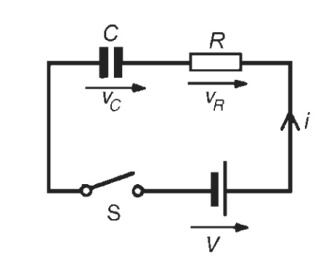 = vC
+ vR
(1)
= vC
+ vR
(1)
Fig. 47. Series RC circuit
(b) The battery voltage V is constant. The capacitor voltage vC is given by q/C, where q is the charge on the capacitor. The voltage drop across R is given by iR, where i is the current flowing in the circuit.
Hence at all times: V = q/C + iR (2)
At the instant of closing S, (initial circuit condition), assuming there is no initial charge on the capacitor, q0 is zero, hence vCo is zero. Thus from equation (1), V = 0 + vRo , i.e. vRo = V.
This shows that the resistance to current is solely due to R, and the initial current flowing, io = I = V/R.
(c) A short time later at time t1 seconds after closing S, the capacitor is partly charged to, say, q1 coulombs because current has been flowing. The voltage vC1 is now q1/C volts. If the current flowing is i1 amperes, then the voltage drop across R has fallen to i1R volts. Thus, equation (2) is now V = q1/C + i1R.
(d) A short time later still, say at time t2 seconds after closing the switch, the charge has increased to q2 coulombs and vC has increased to q2/C volts. Since V = vC + vR and V is a constant, then vR decreases to i2R, Thus vC is increasing and i and vR are decreasing as time increases.
(e) Ultimately, a few seconds after closing S, (i.e. at the final or steady state condition), the capacitor is fully charged to, say, Q coulombs, current no longer flows, i.e. i = 0, and hence vR = iR = 0. It follows from equation (1) that vC = V.
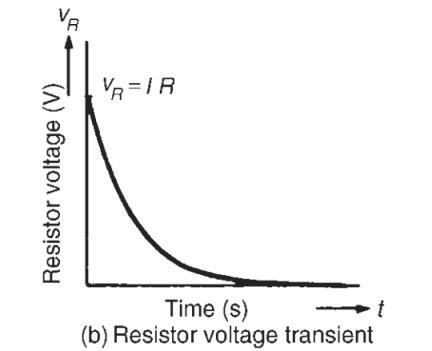
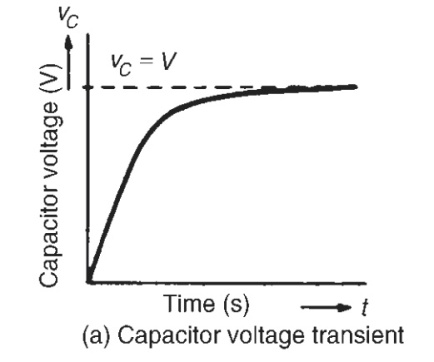 Fig.
48. Capacitor and resistor voltage transients.
Fig.
48. Capacitor and resistor voltage transients.
(f) Curves showing the changes in vC and vR with time are shown in Figure 48. The curve showing the variation of vC with time is called an exponential growth curve and the graph is called the ‘capacitor voltage/time’ characteristic. The curves showing the variation of vR and i with time are called exponential decay curves, and the graphs are called ‘resistor voltage/time’ and ‘current/time’ characteristics respectively. (The name ‘exponential’ shows that the shape can be expressed mathematically by an exponential mathematical equation.)
It may be shown that the transient curves shown in Figure 48 have mathematical equations, obtained by solving the differential equations representing the circuit. In instance of grows of capacity voltage we have:
VC = V(1 – e–t/CR) = V(1 – e–t/τ) (3)
where τ is the time constant, the time taken for a transient to reach its final state if the initial rate of change is maintained.
Transient effects in CR circuits are widely used in specific electronic circuits.
 C
C
Fig.
49. Differential RC fragment of electronic circuit.

Vin(t) R Vout (t)
For example under certain conditions the intensities of input and output signals in simple RC circuit shown in Figure 49 are described with differential equation:
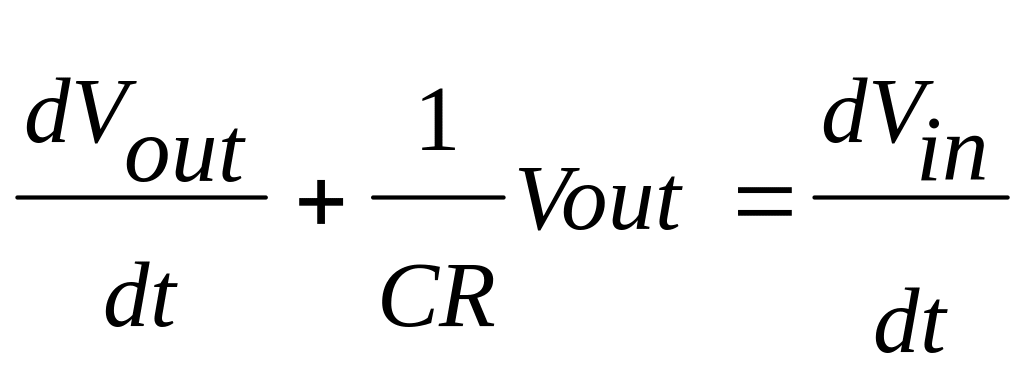 (4)
(4)
Let
![]() ,
then
,
then
![]() ,
(5)
,
(5)
so the circuit performs a function of differentiator.
-
transient
decay
тут: перехідний процес або стан
тут: убування
Why is the process of condenser charging attributed to transients?
What defines the shape of curves in Fig. 48?
What is a physical meaning of time constant τ in equation (3)?
Why do courses of vC and vR curves in Fig. 48 have opposite direction: the first one grows while the other decays?
In what types of electronic circuits may RC fragments be used?
Exercise 2. Explain the terms with other words.
Transient effect, exponential growth curve, exponential decay curve, initial rate, differential equation, electronic circuit, transient curve, RC circuit.
Exercise 3. Find out in the text antonyms to the following words.
Stationary, later, differently, constant, rise, inequality, original, opening, discharged, integrator.
Граматичні відомості
Розгляд ситуацій у минулому, які реально не відбулись (third conditional)
Умовні речення цього типу стосуються подій у минулому, яких насправді не було. Іншими словами, умови, зазначені у такому реченні, не ґрунтуються на реальних фактах. В цілому структура цих речень аналогічна розглянутим вище умовним реченням другого типу, але для передачі абсолютної нереальності подій (не можна змінити те, що вже відбулось) форма Past Simple у підрядній частині замінюється на Past Perfect, а у головному реченні після модального дієслова would, could або might замість звичайного інфінітиву використовується його перфектна форма:
If he had known the password, he would have broken the protection. (In fact he didn’t know so he didn’t break.)
I could have taken a nice picture if I had had a camera with me. (In fact I didn’t have a camera and I couldn’t take any picture.)
Інколи час підрядного речення не співпадає з часом головного: наприклад, умова стосується теперішнього або минулого часу, а наслідок умови – майбутнього. У такому випадку ми маємо справу з так званими ‘змішаними’ умовами ‘mixed conditional’, що складаються з відповідних частин умовних речень другого та третього типів: Sometimes the time in the subordinate (conditional) clause is not the same as the time in the main clause (the clause of result):
I wouldn’t have entered the university (but in fact I did – past) if I didn’t like it (but I do – present).
I could fly to London tomorrow (future) if I had booked a ticket (but I didn’t – past).
If we had brought matches (past), we might light a fire (present).
If he were a good student (present), he would have prepared for the exam (past).
У разі потреби можуть використовуватись і складніші форми часу:
If it had not been raining a lot, the grass would be dry.
Обернений порядок слів в умовних реченнях (inverted conditionals)
Якщо змінити порядок слів у деяких формах умовних речень, сполучник if забирається і ми отримуємо безсполучникову форму:
Had I known the rule, I would have done this exercise. = If I had known…
Were I you, I wouldn’t do that. = If I were you…
Should Peter come, show him a letter. = If Peter should come…
У випадках застосування оберненого порядку слів до заперечних форм речень такі скорочені форми допоміжних дієслів, як shouldn’t, wouldn’t, hadn’t, не використовуються:
Had I not taken a train, I wouldn’t be here. – We can’t use ‘hadn’t I taken’.
Exercise 1. Translate the sentences into English.
Я був під час відпустки у Карпатах. Я поїхав би до Ялти, якби там не було так жарко влітку.
Чому ви не взяли таксі? Якщо б ви це зробили, ви б не запізнилися на літак.
Я був би дуже вдячний, якби Ви так зробили.
Якби ми не їхали так швидко, ми не потрапили б в аварію і ввечері були б уже на місці.
Якби я приніс словник, я міг би перекласти цю статтю прямо зараз.
Exercise 2. Read a situation and then write a sentence with if.
Example. He wasn’t injured in the accident because his seat-belt was fastened. If he had not fastened his seat-belt, he may have been injured.
These companies are seeing profits rise thanks to new investment in computer technologies.
We was able to buy the equipment because we were funded by a grant from the Sikorsky Foundation.
I’m going to buy this book because I know that I’ll get money next week.
You are tired now because you did not sleep well last night.
I didn’t eat anything because I wasn’t hungry at that time.
Exercise 3. Make sentences with the same meaning by omitting if.
Example: If you should see Peter, give him my regards. Should you see Peter, give him my regards.
If they had realized the danger they would have done it another way.
If I were you, I wouldn’t be quarreling with your brother.
If anyone else should call, would you please take a message?
If the bank should close before I get there, I’ll transfer the money tomorrow in the morning.
If everyone had arrived, none of these problems would have happened.
She would have got a better job if she were smarter.
Комунікативна практика
Asking permission
Sometimes you like to do more than you have just been offered—you may have to ask for permission to make sure you are allowed to. The type of request depends on task you want to do as well as on who you are and who you are talking to.
Here are some common ways of asking permission:
May I… Can I… (May is considered more formal than can).
I’d like to…
OK if I …?
Do you mind if I …? (Would you mind… is more polite).
I wonder if I could possibly…?
Here some possible ways to give permission:
Yes, you may.
Please, help yourself.
OK. Sure (go ahead).
Yes, I guess so.
All right.
And you can refuse like this:
No, please don’t.
I’m sorry, you may not.
That’s not a very good idea.
Unfortunately that’s not possible.
Exercise 1. Pretend you are on excursion in Aviation Museum. Work in a small group. One of the students plays a role of a guide. Others request for permissions like the following:
to take pictures
to smoke
to taught some things
to go upstairs into cabin, etc.
Exercise 2. Work in pairs or in a small group. Make a list of 3-4 things you want to do but you have to get someone’s permission for. Than exchange your lists and ask your partner for permission. Be ready to explain your request.
Вправи для самостійної роботи
Exercise 1. Translate the text from pages 286-288 into Ukrainian (Russian).
Exercise 2. Translate the sentences into your home language paying special attention to the meaning of the word number.
They wrote various numbers on a large sheet of paper.
A million pounds seemed a suitably round number.
1, 3, 5, 7, etc. are odd numbers, 2, 4, 6, etc. are even ones.
I gave him my home number.
Answer question number 3.
The number of cars on our roads rose dramatically last year.
I was reading the latest number of 'Nature'.
There is a number of books on English grammar available at this library.
Madonna sang several numbers from her latest album.
Only three of our number could speak Italian.
Exercise 3. Make sentences with the given possibilities using conjunction ‘if’.
Example. I may be late because of the traffic jam.
If I’m late, not wait for me.
If I should be late, you may start on time.
If I were late, don’t worry, it might be because of the traffic jam.
We might have some free time tomorrow.
Maybe it will rain tomorrow.
I will probably too tired tonight.
People might continue to pollute environment.
Prices on new hardware may fall.
Lesson 9
ВИВЧЕННЯ ТЕРМІНОЛОГІЇ ЗА ТЕМОЮ МОДУЛЯ
Exercise 1. Translate the text in written.
The effects of time constant on a rectangular waveform
By varying the value of either C or R in a series connected C–R circuit, the time constant (τ = CR), of a circuit can be varied. If a rectangular waveform varying from +E to –E is applied to a C–R circuit as shown in Figure 50, output waveforms of the capacitor voltage have various shapes, depending on the value of R. When R is small, t = CR is small and an output waveform such as that shown in Figure 51 (a) is obtained. As the value of R is increased, the waveform changes to that shown in Figure 51 (b). When R is large, the waveform is as shown in Figure 51 (c), the circuit then being described as an integrator circuit.
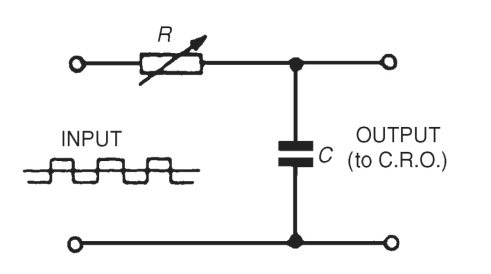
Fig. 50. RC circuit with
variable resistor and
output on the capacitor.

Fig. 51. Influence of R value on output waveform.
If a rectangular waveform varying from +E to –E is applied to a series connected C–R circuit and the waveform of the voltage drop across the resistor is observed, as shown in Figure 52, the output waveform alters as R is varied due to the time constant, (τ = CR), altering.
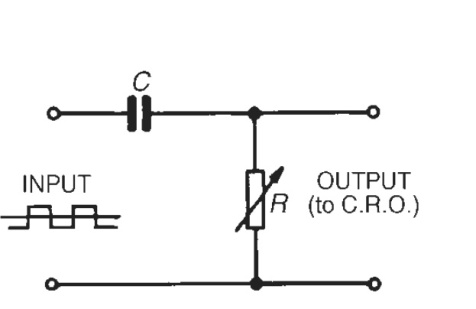
Fig. 52. RC circuit with
variable resistor and
output on the resistor.
When R is small, the waveform is as shown in Figure 53 (a), the voltage being generated across R by the capacitor discharging fairly quickly. Since the change in capacitor voltage is from +E to –E, the change in discharge current is 2E/R, resulting in a change in voltage across the resistor of 2E.
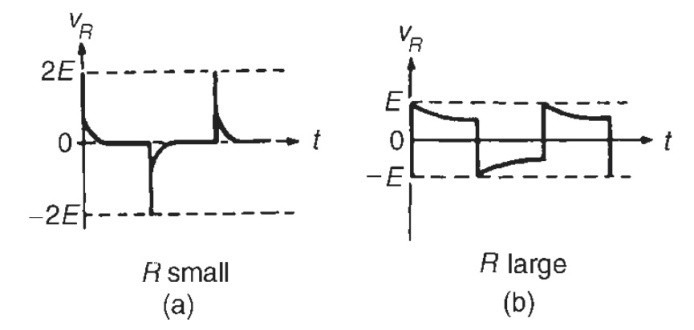
Fig. 53. Influence of
R value on output
waveform.
This circuit is called a differentiator circuit. When R is large, the waveform is as shown in Figure 53 (b).
Exercise 2. Translate the terms into English.
Форма сигналу, падіння напруги, вхідний сигнал, розрядження конденсатору, струм розрядки, змінний резистор.
Exercise 3. Give the words with opposite meaning.
Example: correct – incorrect.
constant differential charged increasing open quickly dependent regular |
|
strong connected large output start complex soft temporary |
|
Граматичні відомості
Непрямі умови (implied conditionals)
Інколи, особливо у розмовній мові, підрядна частина, що містить умову, лише розуміється, але прямо не зазначається. Форма присудку головного речення при цьому не змінюється порівняно зі звичайними умовами:
I would have gone to Paris, but I didn’t know French that time. = I would have gone to Paris if I had known French.
An inspection of the program revealed faults that might otherwise have been overlooked. = If they had not inspected the program…
I'd have traveled all the way to Glasgow for nothing without your help. = … if you hadn’t helped me.
Сполучення should з наступною формою perfect infinitive використовується для висловлення ставлення до подій, що вже відбулись:
You shouldn’t have been all alone so late (but you did)!
You have called me (but you didn’t).
Таке сполучення should, та інших модальних дієслів з перфектним інфінітивом може також використовуватись для характеристики імовірності того, що подія відбулась (або не відбулась) у минулому:
The delegation should (may, might, etc.) have arrived by now.
Exercise 1. Translate the following sentences into English.
Я б прийшов, але я не знав, чи застану тебе вдома.
Я натиснув на гальма. Інакше я врізався б у стіну дома.
Ця програма дуже мені подобається, але я не міг би її встановити, тому що це забрало б забагато оперативної пам’яті.
Я б не зміг вчасно впоратися без твоєї допомоги.
Тобі зараз легко казати, що б ти зробив, але я був самий і не міг розраховувати на допомогу.
Exercise 2. Complete the sentences with appropriate form of the verb from parentheses.
I should have helped him. If I (know) ___________ it before!
Why didn’t you called me? I (come) ___________ immediately!
It’s a pity you didn’t send us any instruction. We (not, have) __________ so much trouble.
If he (be) ________ here! I’d be so glad.
Take an umbrella. Otherwise you (get drenched) ___________.
If only you had worked harder last year! You (know) _____________ English perfectly now.
If only you ________ English well! We (not, embarrass) _________________ so much during yesterday’s reception.
Комунікативна практика
Asking and being asked to do a favor
Listen and read the conversation. Find out the expressions used to ask a favor and to show agreement and gratitude. Then use the conversation as a model to practice the conversation like this.
A: Hi, sorry to bother you…
B: No problem. What is it?
A: My car’s in the garage, something happened with brakes, and I’ve got to visit my mother. You know, she’s living in the suburb of the city right now. Do you think I could use your car?
B: That’s all right, go ahead. I won’t need it until evening anyway. By the way, I’m going to the conference in Chicago, so I have to prepare my report, and won’t go out till Tuesday.
A: Well, maybe you need a quiet place to work for a while. You’re welcome to use my office. I’ve just set there a new air-conditioning.
B: Thanks a lot! Oh, before you go, could I ask you a favor?
A: Sure.
B: While you’re possibly at the store, could you pick up some milk and a loaf of bread for me?
A: Sure, I’d be glad to.
Вправи для самостійної роботи
Exercise 1. Translate in written the text from pages 291-292 into Ukrainian (Russian).
Exercise 2. Complete the sentences with the verbs in parenthesis.
I have to work this afternoon, but if I (have, not) __________ , I (visit) _________ the exhibition.
Hydrogen is far lighter than air. If it (be, not) _________, a balloon wouldn’t float upward.
I called my mother to tell her I would be late. If I (call, not) _________, she (get worried) ____________ about me.
What (you, use) _______________ to look at yourselves when you comb your hair if you (have, not) any mirror?
It’s been raining hard for over a month. If it (stop, not) _____________, a lot of crops (die) ____________.
I am not a good cook, but if I (be) ________, I (prepare) __________ my own cake yesterday.
Exercise 3. Make your own conditionals of different types (real, unreal for the future, unreal for the past, mixed).
Lesson 10
ВИВЧЕННЯ ТЕРМІНОЛОГІЇ ЗА ТЕМОЮ МОДУЛЯ
Learn the text and then answer the questions.
Three-phase ac supply
G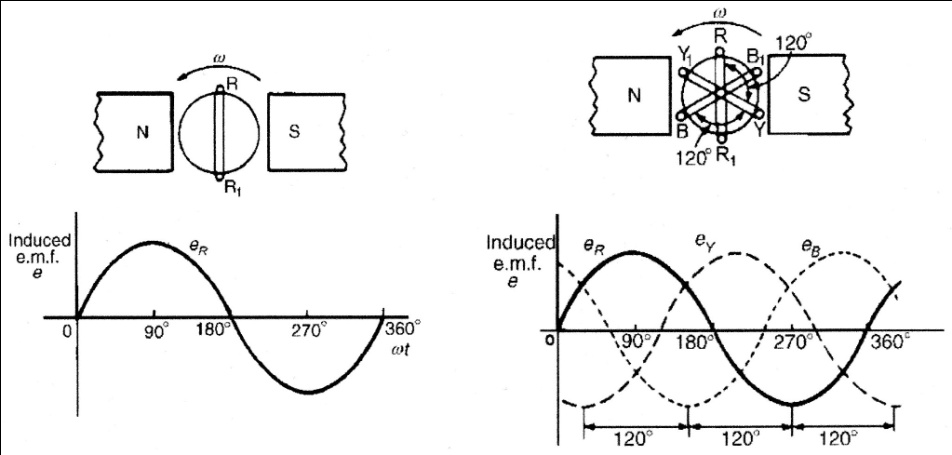 eneration,
transmission and distribution of electricity via the National Grid
system is accomplished by three-phase alternating currents. The
voltage induced by a single coil when rotated in a uniform magnetic
field is shown in Figure 54 a and is known as a single-phase voltage.
eneration,
transmission and distribution of electricity via the National Grid
system is accomplished by three-phase alternating currents. The
voltage induced by a single coil when rotated in a uniform magnetic
field is shown in Figure 54 a and is known as a single-phase voltage.
a b
Fig. 54. One (a) and three (b) phase AC supply.
Most consumers are fed by means of a single-phase AC supply. Two wires are used, one called the live conductor (usually colored red) and the other is called the neutral conductor (usually colored black). The neutral is usually connected via protective gear to earth, the earth wire being colored green. The standard voltage for a single-phase AC supply is 240 V. The majority of single-phase supplies are obtained by connection to a three-phase supply (see Figure 55).
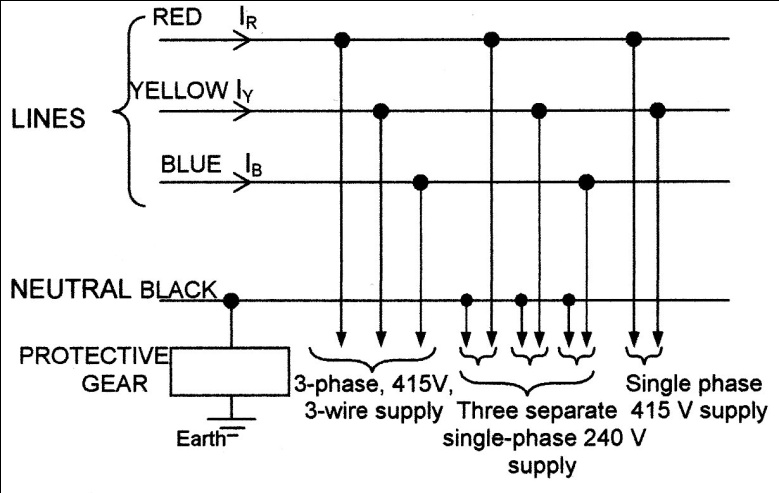
Fig. 55. Connection of individual consumers of one phase ac supply to
a three phase power grid.
A three-phase supply is generated when three coils are placed 120° apart and the whole rotated in a uniform magnetic field as shown in Figure 54 (b). The result is three independent supplies of equal voltages which are each displaced by 120° from each other. The convention adopted to identify each of the phase voltages is: R-red, Y-yellow, and B-blue, as shown in the Figure. The phase-sequence is given by the sequence in which the conductors pass the point initially taken by the red conductor. The national1 standard phase sequence is R, Y, B.
A three-phase AC supply is carried by three conductors, called ‘lines’ which are coloured red, yellow and blue. The currents in these conductors are known as line currents (IL ) and the p.d.’s between them are known as line voltages (VL ). A fourth conductor, called the neutral (coloured black, and connected through protective devices to earth) is often used with a three-phase supply.
If the three-phase windings shown in Figure 54 b are kept independent then six wires are needed to connect a supply source (such as a generator) to a load (such as motor). To reduce the number of wires it is usual to interconnect the three phases. There are two ways in which this can be done, these being:
(a) a star connection, and (b) a delta, or mesh, connection. Sources of three-phase supplies, i.e. alternators, are usually connected in star, whereas three-phase transformer windings, motors and other loads may be connected either in star or delta.
What advantages has three-phase ac generation over one-phase one?
Is it possible to use power supply with a number of phases more or fewer than three? If so, why such supplies are not practically used?
Which equivalents of voltages presented in Figure are used in Ukraine?
What types of load connections are used in three-phase supply?
Why do phase wires have standard color marks?
Граматичні відомості
Граматичні структури для висловлення побажань
Коли ми висловлюємо побажання, аби реальність змінилася, не була такою, якою вона є насправді, використовуються згадані вище форми дієслів, що характерні для другого та третього типів умовних речень, у сполученні зі словами ‘wish’, ‘if only’, або ‘I’d (I would) rather’:
I wish my English were perfect (it is not true right away).
I’d rather you didn’t smoke (but you do).
If only you had come yesterday (but you didn’t).
I wish the rain would stop (I want the rain to stop in the future; I’m not sure that it’ll be realized in the nearest future).
I wish it weren’t raining right now (in fact it’s raining).
If only Peter were here, I wish he had already come.
‘Wish’ у сполученні з наступним would’, може висловлювати нетерпіння, дратування або шкоду щодо того, що хтось продовжує це робити:
I wish you’d never say this again.
I wish it would stop raining.
Якщо побажання стосується обставин, які не можуть змінитися за бажанням особи, слово ‘would’ не використовується:
I wish he were smarter. (We can’t use ‘he would be’ because we don’t suppose he could control his mind.)
I wish I could quit my job and go traveling in South America. (I can’t use ‘I wish I would’ because I should have control over what I am willing to do.)
But I can say about someone: I wish he would quit his job …, because it means I wish he were willing …
Фраза ‘I wish you would…’ часто вживається для прохання чи поради:
We are late. I wish you’d hurry. (I ask you to hurry).
Exercise 1. Complete the sentences with appropriate ending.
Example. I can’t speak English fluently, but I wish I … could.
I still haven’t finished my work, but I wish I …
It probably won’t happen, but I wish it …
I didn’t go to the conference, but I wish I …
I am so tired. I wish I …
I haven’t passed the exam, but I wish I …
He didn’t buy a ticket, but he wish he …
Exercise 2. Supply an appropriate form.
I need some help. I wish my friend (be) _______ here now. If he (be) ________, I could finish very quickly.
I had a good time in the Crimea over vacations. I wish you (come) ____________ with us. If you (come), you (have) _______________ a good time.
The phone’s been ringing over and over again. I wish someone (answer) __________ it.
It makes me nervous. I wish you (not, drive) _________ so fast.
Shall I stay here? – Well, I (rather, you to come) _________ with us.
What are you going to do? – I (rather, to stay) ___________ here.
You don’t look very well. You (better, not to go) _________ to work today.
Комунікативна практика
Starting a business conversation, making request
Exercise. A newspaper correspondent is visiting a military airfield. Read the text as you listen to the conversation. Find out the common expressions used to start a conversation, polite forms of request, agreeing and refusing.
Officer: Come in, come in... Good afternoon.
Reporter: Good afternoon, sir. How are you? Fine, I hope.
Officer: Yes, thanks. How are you?
Reporter: Great! I’m Frank Smith.
Officer: Yes, I know. You’re the reporter.
Reporter: Yes, that’s right. We talked last month. May I record?
Officer: Sure.
Reporter: May I put the recorder on this table?
Officer: No, could you put it here please.
Reporter: Of course, this is fine.
Officer: What can I do for you, Frank?
Reporter: I want to write some stories.
Officer: What about?
Reporter: I want to write about the planes and helicopters, and a man.
Officer: Good. I’ll ask lieutenant to show you around.
Reporter: May I look at the planes?
Officer: OK. Look at the planes, talk to the pilots.
May I look around the airfield?
Officer: Of course. Some parts of the area are off limits.
Reporter: What do you mean?
Officer: You can’t go some places. You can’t see everything.
Reporter: May I ask why?
Officer: For security. It’s a military object, you know. Lieutenant will keep you out of trouble. Would you like a drink?
Reporter: May I have some coffee?
Officer: Sure. What would you like to see, Frank?
Reporter: I write about people usually. Is it all right to talk to the men?
Officer: What about?
Reporter: I want to describe their lives, what they do every day.
Officer: That’s fine.
Reporter: May I ask them about their work?
Officer: I don’t mind. They won’t tell you any secrets. Oh, good, here is your coffee.
Вправи для самостійної роботи
Exercise 1. Insert the missing parts of the words.
In a three-p_____e system, three circuit conductors carry three alternating currents (of the same f________cy) which reach their instantaneous peak values at different times. Taking one c________or as the reference, the other two currents are delayed in time by one-third and two-thirds of one c_____e of the electric current. This delay between ph_____ has the effect of giving constant power transfer over each cycle of the current and also makes it possible to produce a rotating m________ic field in an electric motor.
Three-phase systems may have a n_______l wire. A ne_______ wire allows the three-phase s_____m to use a higher voltage while still supporting lower-voltage single-phase appliances. In high-voltage distribution situations, it is common not to have a ______ral wire as the loads can simply be connected between phases (phase-phase connection).
Three-phase has properties that make it very desirable in electric p____r systems:
The phase currents tend to cancel out one another, summing to ___ro in the case of a linear balanced load. This makes it possible to eliminate or reduce the size of the n______l conductor; all the phase conductors carry the same current and so can be the same size, for a ba_____ed load.
Power transfer into a l_____r balanced load is constant, which helps to reduce generator and motor vibrations.
Three-phase systems can produce a magnetic field that r_____es in a specified direction, which simplifies the design of electric motors.
Three is the lowest p____e order to exhibit all of these properties.
Exercise 2. Translate the text from Exercise 1 in written.
Lesson 11
ВИВЧЕННЯ ТЕРМІНОЛОГІЇ ЗА ТЕМОЮ МОДУЛЯ
Exercise 1. Translate the text in written form.
Star and delta connections in the power grid
Star connection
A star-connected load is shown in Figure 23 where the three line conductors are each connected to a load and the outlets from the loads are joined together at N to form what is termed the neutral point or the star point.
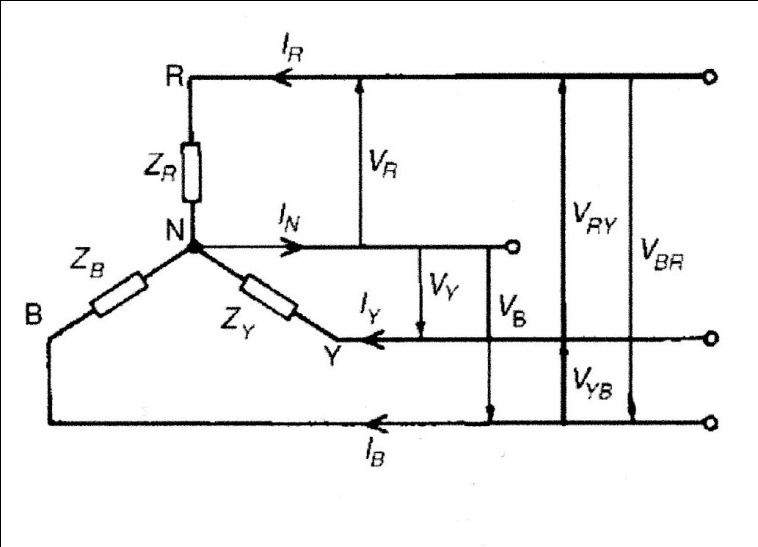
Fig. 56. The star connection.
The voltages, VR , VY and VB are called phase voltages or line to neutral voltages. Phase voltages are generally denoted by Vp. The voltages, VRY, VYB and VBR are called line voltages.
From Figure 23 it can be seen that the phase currents (generally denoted by Ip) are equal to their respective line currents IR , IY and IB, i.e. for a star connection:
IL = Ip
For a balanced system: IR = IY = IB , VR = VY = VB
VRY = VYB = VBR , ZR = ZY = ZB
and the current in the neutral conductor, IN = 0.
When a star connected system is balanced, then the neutral conductor is unnecessary and is often omitted.
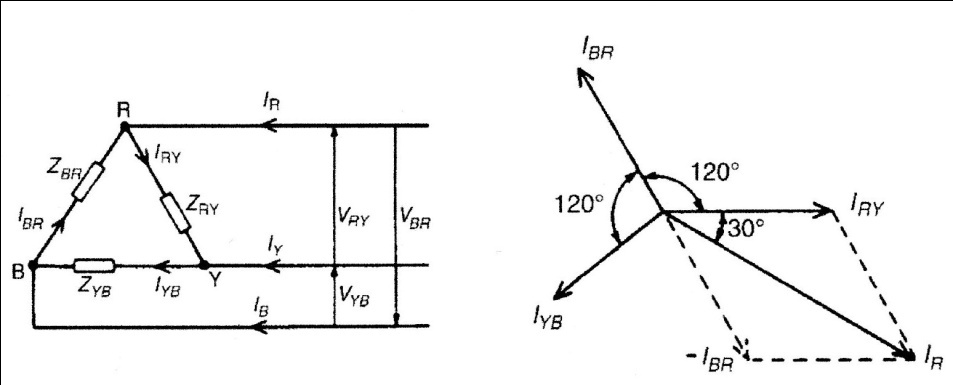 a
b
a
b
Fig. 57. Voltages and currents in a star connected system.
The line voltage, VRY, shown in Figure 57 (a) is given by
VRY = VR – VY (VY is negative since it is in the opposite direction to VRY).
In the phasor diagram of Figure 57 (b), phasor VY is reversed (shown by the broken line) and then added phasorially to VR (i.e. VRY = VR + (–VY)). By trigonometry, or by measurement, VRY = √3VR , i.e. for a balanced star connection:
VL = √3Vp
The star connection of the three phases of a supply, together with a neutral conductor, allows the use of two voltages — the phase voltage and the line voltage. A 4-wire system is also used when the load is not balanced. The standard electricity supply to consumers in Great Britain is 415/240 V, 50 Hz, 3-phase, 4-wire alternating current, and a diagram of connections is shown in Figure 55.
Delta connection
A delta (or mesh) connected load is shown in Figure 58 where the end of one load is connected to the start of the next load. From Figure 25, it can be seen that the line voltages VRY, VYB and VBR are the respective phase voltages, i.e. for a delta connection:
V = Vp
Using Kirchhoff’s current law in Figure 58, IR = IRY – RBR = IRY + (–IBR). From the phasor diagram shown in Figure 59, by trigonometry or by measurement, IR =√ 3IRY, i.e. for a delta connection: IL = √3Ip
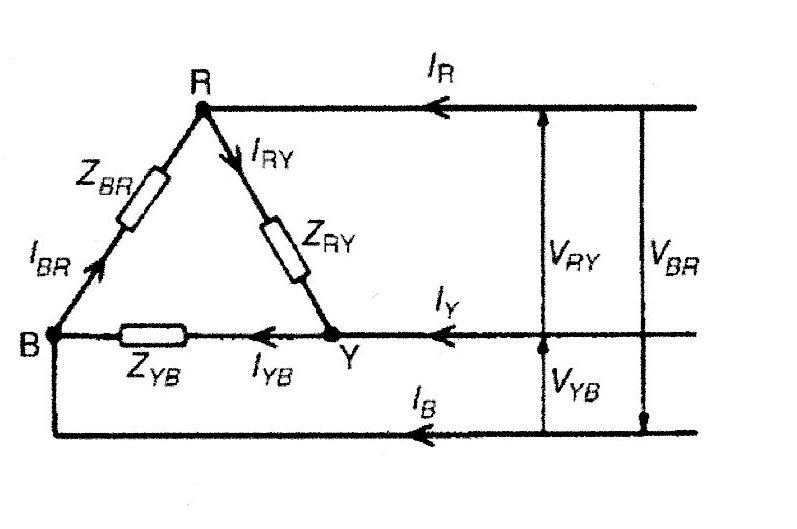
Fig. 58. The delta connection.
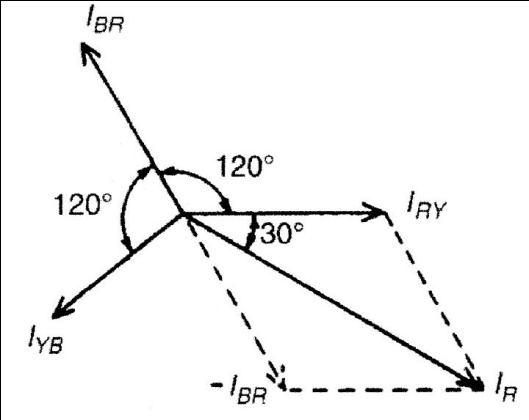
Fig. 59. Phasor diagram for a delta connected system.
Граматичні відомості
Emphatic structures. Untypical word order
We have already discussed that words in English sentence have a strict order (Module 5, Lesson 1). Nevertheless the canonical word order may be changed or inverted. Inversion can be used as a means of stressing or emphasizing an idea. Usually, the question form (auxiliary + subject + main verb) takes the place of the standard positive sentence structure (i.e. He goes to work every day). We considered such a case in Lesson 5 (inverted conditional). Generally, an inversion is used to stress the uniqueness of an event and begins with a negative (seldom, rarely, never):
Never have I been more insulted!
Seldom has he seen anything stranger.
Time expressions with words hardly, barely, no sooner, or scarcely are used when a there are a succession of events in the past:
Scarcely had I got out of bed when the doorbell rang.
No sooner had he finished dinner, when she walked in the door.
In similar expressions with ‘only’ and ‘little’ these words are usually followed by auxiliary ‘do/does/did’ to make an additional stress:
Only then did I understand the problem.
Only after understanding the situation does the teacher make a comment.
Little did he understand the situation.
Inversion often follows introductory emphatic word ‘so’ and ‘such’:
So difficult is the test that students need three months to prepare.
Such is the stuff of life.
You should be careful while translating such sentences into your native language. We often express a stress with specific means which could be quite different in different languages:
Little have I read concerning nanotechnology. – Як мало я читав про нанотехнології.
In Ukrainian translation we add word ‘як’ which does not have direct equivalent in English. Something like this we have while translating Ukrainian ‘невже’. To express surprise we use a specific form of negative question:
Невже він це чув? – Hasn’t he heard that?
Exercise 1. Translate into Ukrainian (Russian) the following sentences. Explain the grammar forms that are used in them to express emphasis.
Hardly had I arrived when he started complaining.
Little did I understand what was happening.
Seldom have I felt so alone.
Inside the house were two detectives.
I do believe that you should think twice about this situation.
Not only do I enjoy classical music, but I also have a season ticket to the symphony.
Seldom has the boss been so upset!
Little did he understand the situation.
So strange was the situation that I couldn't sleep.
Should he decide to come, please telephone.
Комунікативна практика
Contractions (short forms) of pronunciation
In spoken English are usually used shorter forms of many common words, first of all, auxiliary verbs: 'm = am, 's = is or has or does, 're = are, 've = have, 'll = will or shall, 'd = would or had. Unfortunately sometimes there is some kind of vagueness while using contractions. For example we have to decide from context if 's means is or has. There are a few examples of contractions:
He's fine. (= He is fine.)
He's gone away. (= He has gone away.)
I'd like some coffee. (I would like some coffee.)
You'd better not go there. (You had better not go there.)
Peter's going out tonight. (Peter is going out tonight.)
These short forms are not used if the verb is stressed, for instance at the end of a sentence:
‘Are you tired?’ – ‘Yes, I am.’ (‘Yes, I’m’ is not used.)
Short forms of auxiliary verbs + not are used as well: isn't, won't, couldn't, shan't, daren't, etc.
Note that in negative form are often used two forms of contraction:
he isn't and he's not
you haven't and you've not.
More sophisticated forms of contractions are often used. For instance, in combination of must have followed by past participle must have, or must’ve, is often pronounced ‘musta’ [mʌstə]:
He musta been sick yesterday. (He must have been sick.)
Similarly 'going to' is often pronounced as 'gonna' [gənə]:
This isn't gonna be easy. (This is not going to be easy.)
Be careful! Many forms of contraction are considered as slang. In official writing including business documentation contractions are not usually used.
Exercise. Change the sentences with contractions into a full form.
Example. I’m going to the party tonight. I am going…
He’s just told me about it.
If only you’d told me earlier.
I’d rather you’d asked me before you’d written to complain.
He musta forgotten about the date.
How's he plan to do that?
A spider's got eight legs.
If you’d asked then, we’d be there right now.
Where'd you get that?
If you don’t hurry, we won’t be home before noon.
You can't phone her now - it's gone midnight.
Вправи для самостійної роботи
Exercise 1. Complete the sentences with the words from the box.
Rather than having six _________ coming out of the three-phase alternator, the same leads from each phase may be _________together to form a star or Y (is red ‘wye’) connection. It is called a Y connection because, without the neutral, the windings appear as the ______Y, in this case sideways or upside down. The neutral connection is brought out to a terminal when a ________-phase load must be supplied. Single-phase voltage is available from neutral to A, neutral to B, and neutral to C. In a three-phase, Y-connected alternator, the total voltage, or line voltage, across any two of the three line leads is the vector sum of the ___________ phase voltages. Each line voltage is 1.73 times one of the __________ voltages. Because the windings form only one path for __________ flow between phases, the line and phase currents are the same (equal). A three-phase stator can also be connected so that the phases are connected ________; it is now delta connected. (Delta because it looks like the ________ letter delta, Δ.) In the delta connection, _________ voltages are equal to phase voltages, but each line current is equal to 1.73 times the phase current. Both the Y and the _________ connections are used in alternators. The majority of all alternators in use in the Navy today are three-phase _________. They are much more efficient than either two-phase or single-phase ___________. The stator coils of three-phase alternators may be joined together in either Y or delta connections. With these connections only three wires come out of the alternator. This allows convenient connection to three-phase motors or power distribution ____________. It is ___________ to use three-phase transformers or their electrical equivalent with this type of system
leads connected letter single individual phase current end-to-end Greek line delta machines alternators transformers necessary |
Exercise 2. Translate the text from Exercise 1.
Exercise 3. Translate the sentences. Explain the function of do/does: auxiliary, emphatic, or substitutive.
This field does not affect the forward motion of the electrons but does act upon the transverse motion.
Not all metals react with acids, and when they do the gas evolved is not always hydrogen.
Gold usually occurs in the natural state while iron does not.
The individual electrons do not move even approximately independent of the another as do, for example, the planets in the solar system.
Copper does not combine with oxygen when cold, but it does do so slowly when heated.
The beta-rays which do pass through the aluminium do not ionize the gas as profusely as do the alpha-rays.
Most authorities agree that catalysts do in some manner combine with the substance or substances upon which their catalytic influence is exerted.
Lesson 12
ВИВЧЕННЯ ТЕРМІНОЛОГІЇ ЗА ТЕМОЮ МОДУЛЯ
Exercise 1. Learn the text and then answer the questions1.
North American power supply
Single-phase loads may be connected to a three-phase system in two ways. A load may be connected across two of the three phase conductors, or a load can be connected from a live phase conductor to the system neutral. Single-phase loads should be distributed evenly between the phases of the three-phase system for efficient use of the supply transformer and supply conductors. Where the line-to-neutral voltage is a standard utilization voltage (for example in a 240 V/415 V system), individual single-phase utility customers or loads may each be connected to a different phase of the supply. Where the line-to-neutral voltage is not a common utilization voltage, for example in a 347/600 V system, single-phase loads must be supplied by individual step-down transformers.
In a symmetrical three-phase system, the system neutral has the same magnitude of voltage to each of the three phase conductors. The voltage between line conductors (Vl) is √3 times the phase conductor to neutral voltage (Vp). That is: Vl=√3Vp.
In multiple-unit residential buildings in North America, three-phase power is supplied to the building but individual units have only single-phase power formed from two of the three supply phases. Lighting and convenience receptacles are connected from either phase conductor to neutral, giving the usual 120 V. High-power loads such as cooking equipment, space heating, water heaters, or air conditioning can be connected across both live conductors to give 208 V. This practice is common enough that 208 V single-phase equipment is readily available in North America. Attempts to use the more common 120/240 V equipment intended for three-wire single-phase distribution may result in poor performance since 240 V heating equipment will only produce 75% of its rating when operated at 208 V.
Where three phase at low voltage is otherwise in use, it may still be split out into single phase service cables through joints in the supply network or it may be delivered to a master distribution board (breaker panel) at the customer's premises. Connecting an electrical circuit from one phase to the neutral generally supplies the country's standard single phase voltage (120 V AC or 230 V AC) to the circuit.
The currents returning from the customers' premises to the supply transformer all share the neutral wire. If the loads are evenly distributed on all three phases, the sum of the returning currents in the neutral wire is approximately zero. Any unbalanced phase loading on the secondary side of the transformer will use the transformer capacity inefficiently.
How different are American standards of industrial power supply from those adopted in Ukraine and Europe?
What are advantages of symmetrical three-phase system?
Why is it preferable to supply standard utilization voltage?
What may the phase current unbalance result?
What common voltages in power grids are used in USA?
Exercise 2. Fill in the gaps in the following text with the words from the box.
If the supply neutral of a three-phase system with line-to-neutral connected loads is broken, the voltage _________on the loads will no longer be maintained. The neutral point will tend to drift toward the most heavily loaded _________ , causing undervoltage conditions on that phase only. Correspondingly, the lightly loaded phases may approach the line-to-line voltage, which exceeds the line-to-neutral voltage by a __________ of √3, causing overheating and failure of many types of loads.
For example, if several houses are connected through a 240 V transformer, which is connected to one phase of the three phase system, each house might be affected by the __________ on the three phase system. If the neutral connection is broken somewhere in the system, all equipment in a house might be damaged due to over-voltage. A similar phenomenon can exist if the house _________ (connected to the center tap of the 240 V pole transformer) is disconnected. This type of failure event can be difficult to troubleshoot if the __________ neutral effect is not understood. With inductive and/or capacitive loads, all phases can suffer damage as the reactive current moves across abnormal paths in the __________ system, especially if resonance conditions occur. For this reason, neutral connections are a critical part of a power network and must be made as reliable as any of the phase connections.
balance neutral factor phase drifting imbalance distribution unbalanced |
-
live phase
neutral
master distribution board
to unbalance
imbalance
multiple-unit residential building
робоча фаза
нульова фаза
щиток
вивести з рівноваги
відсутність рівноваги
багатоквартирний будинок
Граматичні відомості
Word formation
Many English words are formed from combinations of other words (man of God, manhole, man-eater) or from combination of words and prefixes or suffixes (man, mankind, manned, unmanned, mannish, mannishly, manhood). As a rule suffixes and prefixes have standard meaning. So if you know what each of the parts means, you will often be able to guess the meaning of a new word without a dictionary. It is easy to understand to native Ukrainians and Russians because the same concepts of the root and related words we have in these languages.
A prefix is added to the beginning of a word to make another word. A prefix can be either a short word, or a group of letters that are not self-dependent. An example of the first type is self–. Self- means ‘yourself’ or ‘itself’. So if you make your self-portrait, you are painting or photographing yourself, and if you have bought a self-adhesive envelope it means that it has a sticky surface and does nor need liquid or glue to make it stay closed. An example of the second type is –non, which means ‘not’. So if you read the sign ‘For non-smokers’ it means that the area is reserved for people who do not smoke.
A suffix is added to the end of a word to make another word. A prefix can be either a short word, or a group of letters that are not self-dependent. An example of the first type is –rich, which is added to nouns to make adjectives for describing something that contains a lot of something. So protein-rich foods contain a lot of protein and oxygen-rich water is saturated with oxygen. An example of the second type is –ish, which means ‘slightly’ or ‘rather’. So reddish fluid looks slightly red.
A word affix is also quite extensively used to refer either to a prefix or a suffix. It is interesting to note that the words ‘prefix’, ‘suffix’, and ‘affix’ themselves can all be considered as formed from ‘fix’ (attached) by the use of prefixes:
a[d] (to) pre (before) su[b] (under) |
+ fix + fix + fix |
= affix = prefix = suffix |
In the appendix are given meanings of the most common English affixes. Be careful, sometimes direct application of affix meaning may be confusing due to casual coincidence of beginning or ending of the word with some affix. For example meaning of in- in such words as ‘inflammable’, ‘infamous’, and ‘input’ does not mean negation which we have in words ‘inability’, ‘insane’, and ‘inadequate’.
Using affixes is not the only way to form new words. Many English words are compounds. They are formed by combining two or three words. Sometimes these parts remain as separate words (man of God), sometimes they combines with hyphens (man-of-war), or may arrange complete word (policeman). Sometimes the meaning of a new compound word is obvious like in examples above. However, a soap opera may not contain any songs and has nothing to do with soap; it is a serial show and the only reason the soap is mentioned that the show makes some women cry like the soap makes little children.
More sophisticated way to form of a new word is combining part of one word with part of another: modem = modulator + demodulator, transistor = transfer + resistor, brunch = breakfast + lunch (the meal eaten in the late morning).
Some new words are formed from the first letters of the words in the compound or phrase: CD-ROM, MS-DOS, NATO, PR, etc. Sometimes these words are pronounced as entire word (NATO, AIDS, DOS, ROM), sometimes as the name of the initial letters (CD, MS, PR, HTML, A.M., P.M., B.C., FBI).
Exercise 1. Guess which words have combined to form the following terms; try to explain their meaning:
emoticon, netiquette, netizen, technophobe, laser, A.D.
Exercise 2. Fill in the blanks transforming the words in brackets.
The government responded ______________ to the new offer of the opposition. (caution)
Ms Planes was not _______ with the hotel so she decided to complain to the manager. (satisfy)
The courts served as a safety-valve, acting as an alternative to __________ when emotions ran high. (violent)
Clearly, more and better research will be required if science hopes to find a cure for diet-related ___________ in our lifetime. (stupid)
Janet _______ broke a plate while doing the washing up. (accident)
Despite hours of discussion, the members of the board could not reach _______. (agree)
Peter improved his _______ of the world during the year he spent traveling. (know)
Exercise 3. Give opposites of the following words:
patient, possible, sane, honest, legal, convenient, logical, polite, attractive, regular, personal, friendly, colorful, tasteful, to pronounce, to understand, to dress.
Вправи для самостійної роботи
Exercise 1. Translate the text from the pages 310-311 (Exercise 2) into Ukrainian (Russian).
Exercise 2. Fill in the missing words into the correct spaces.
Verb |
Noun |
suggest invite style
appoint
enjoy wait |
conclusion executer shaking
isolation
|
Exercise 3. Rewrite the sentences using non-finite forms of the verb.
I expect that my friends will come to my birthday party.
He wants that the work will be done at once.
They say that he has been appointed a staff manager in a big company.
It appears that the weather is improving.
Thank that you have come.
I was surprised when I heard this.
There is no harm when someone is doing that.
A cup which was broken lay on the table.
While we were unwrapping the computer we found the broken screen.
Mars rover will make risky trip into crater.
Lesson 13
Підготовка до модульної контрольної роботи
Revision of topics discussed in lessons 1-12. Every students of the group makes a report devoted to types of electric circuits and their applications in electric and electronic gadgetry.
Вправи для самостійної роботи
Нижче наведені типові приклади завдань з граматики, що можуть бути використані під час письмового тесту.
Exercise 1. Translate the following text in written.
Transistors and other semiconductor devices come in a wide variety of types capable of performing many different functions when linked together with other elements into electronic circuits. The most important of these other elements are resistors, which impede the flow of electrons and regulate voltages and currents; conductors, which connect different circuits or different circuit elements together; and capacitors, which store electrical charges.
The functions that such circuits perform are generally of two broad types: logic circuits transform or process information carried by electronic signals, while memory circuits and devices store the information. Logic circuits are built up out of identical components that perform elementary manipulations on each piece of information, called a bit. A bit consists of either a 1 or a 0. Sometimes another unit of information, known as a byte, or eight bits, is also used.
There are three basic types of logic circuits: AND, OR, and NOT. NOT circuits are combined with AND and OR circuits to make NAND and NOR circuits. In an AND gate, two inputs produce an output only if both inputs are 1.
Exercise 2. Translate into English.
Ця модель комп’ютера подібна до моделі 12 у вашому каталозі.
Давайте все зробимо по-іншому.
Я думав, що ви розпочали ці дослідження ще до останньої публікації професора Сміта.
Якщо це буде Петро, запитай його, чи він приїде завтра.
Якби ти був уважнішим, то не ставив би таких питань.
Тобі не слід було поспішати, їх все одно ще нема.
Для того, щоб вчасно виконати завдання, нам потрібне достатнє фінансування проекту.
Він запитав, з якого металу зроблено покриття мікросхеми.
Exercise 3. Render direct speech into reported one and vice versa.
They said there the buildings were taller, the cigars were longer, and the girls were prettier than anywhere.
He said, “Do you know that the Caspian Sea is the biggest lake?”
He said that if he saw her, he would have told her about it.
He asked her to go to the movie, but she refused.
He asked a porter to take a trunk.
He asked me, “Let’s go to Helen, shall we?”
He asked me where I had been the day before.
Exercise 4. Complete the sentences using the proper forms of the verbs in brackets.
The weather certainly (to change) for the better after the rain (to stop) and the sky (to clear up).
He usually (not have) coffee at this time. Why he (to drink) it now?
It (to snow) heavily. You (to listen) to the weather forecast for tomorrow? I (to hope) it (to stop) snowing by tomorrow morning.
George (to fall) off the ladder while he (to paint) the ceiling.
When you (to get) this wonderful ring? – I (not remember). I (to have) it for years.
Exercise 5. Insert prepositions where necessary.
My sister is always angry … me.
Why don’t you do something instead … just talking?
I’m sorry … being so late … Monday.
The windows haven’t been cleaned … weeks.
I hope to see Ann … lunch time.
Aren’t you coming … us? No, I’m waiting … Tom.
He’s heard such a lot … her that he’s looking forward … seeing him very much.
It is necessary … them to be there.
He was too weak _____ hunger to cry.
Exercise 6. Explain the terms below with other words.
parallel processing
programming
CPU
storage device
display
input device
generation of computer
Exercise 7. Fill in the blanks in sentences using the terms of module 4.
Large transformers are used in electric ___________ systems, and small units in electronic devices.
Industrial and residential power transformers that operate at the line ____________ (60 Hz in the U.S.), may be single ________ or three-_________, and are designed to handle high voltages and currents.
Efficient power transmission requires a ________-up transformer at the power-generating station to raise voltages, with a corresponding decrease in current.
Line power losses are proportional to the square of the current times the resistance of the power line, so that very high voltages and low _________ are used for long-distance transmission lines to reduce losses.
At the receiving end, ________-down transformers reduce the voltage, and increase the __________, to the residential or industrial voltage levels, usually 115 to 600 V.
Exercise 8. Use these words and their combinations to make sentences:
transient, wave form, single-phase, star connection, RC circuit, parallel connection, rectifier.
Module 5. METROLOGY AND CONTEMPORARY
SYSTEM OF UNITS
Lesson 1
ВИВЧЕННЯ ТЕРМІНОЛОГІЇ ЗА ТЕМОЮ МОДУЛЯ
Exercise 1. Learn the text and then answer the questions.
